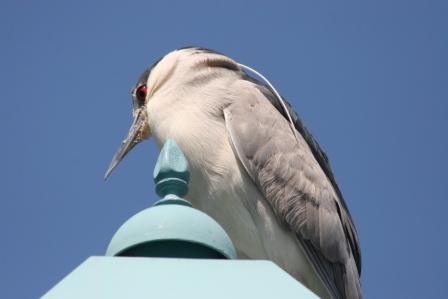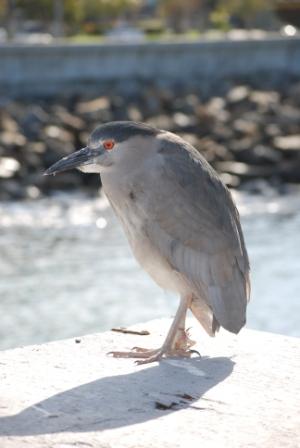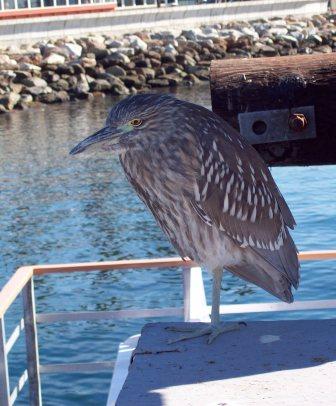
Adult black-crowned night heron, white plume showing
It’s a statue, it’s a fake bird, no wait, is that a bird? This is the series of thoughts that ran through my mind the first time I saw a stout, squat, perfectly still bird sitting on the Redondo Pier. This bird didn’t move an inch, even when I was standing less than a foot away. Before writing it off as fake, I asked other people standing around if they knew what it was. The answer: a black-crowned night heron or Nycticorax nycticorax.
According to The Audubon Society Encyclopedia of North American Birds, nycticorax derives from the Greek word nyktikorax meaning night raven. Possibly Linnaeus, the father of modern taxonomy who scientifically named thousands of species, suffered a second nervous tic (the first when naming the Mola mola) and wrote the same name down twice on accident for the black-crowned night heron.
Black-crowned night herons usually appear out of nowhere. Suddenly there’s a bird, sitting on a boat in the harbor or at the end of the Redondo Pier. Or maybe it was there all along, but as a master of motionlessness it blended in with the landscape and then suddenly your eyes revealed its presence, just like looking at a 3D optical illusion.
It turns out these mysterious birds are the most wide-spread heron in the world and are found on every continent except Australia and Antarctica. Then why do we only see one black-crowned night heron here or there? The first clue is the word “night” in their name, they are nocturnal. And the reason they are so still? They’re sleeping! Or at least trying to.
According to the Birds of North America database, they “sometimes sleep in direct sunlight, presumably for warming.” Now everything about black-crowned night herons makes so much more sense! But staying still may have another purpose besides sleeping. Roger Hothem, a wildlife research biologist with the U.S. Geological Survey’s Western Ecological Research Center said, “Night herons may be sleeping at times. However, we have observed night herons near water apparently motionless, followed by a quick strike to capture a fish or crab, or crayfish, or rodent or snake.”
This daytime sleeping habit or stationary hunting style is one of the best ways to identify night herons. While most other birds are busy preening, hunting or flying, black-crowned night herons are completely immobile. The next best identifying characteristic is their very unique body-shape. Night herons are stocky, have no real neck, and reach a respectable height of 26 inches. They look very sturdy perched on boat masts and pier railings; you might even think: “That looks like a very practical, no non-sense bird.”

Adult black-crowned night heron with pink legs
Young black-crowned night herons apply practical to their plumage with sensible brown and white-spotted feathers sitting atop thick yellow legs. Adults ditch the practicality, molt the juvenile feathers, and eventually acquire a sleek dark blue-black back, gray feathers on the wings and a white underside.
The deep blue-black feathers extend to the top of the head, but the feathers on the side of the face are light gray, which gives the appearance of a cap or crown, hence the name black-crowned night heron. As the sun sets, night herons are easily identified by their loud distinct calls that sound like a yelping small dog with a sore throat.
Adult males and females look identical; both have trendy red eyes and a couple of white plumes that hang from the back of the head down the back. Plumes look like slender white ropes, true accessories considered to be ornamental feathers. Typical of nature, extraneous frills tend to play a role during breeding season and plumes are no exception.
“They are secondary sex characteristics,” said Hothem. In fact, white plumes are so important that if they are removed the chance of males and females pairing up for breeding season is reduced, and if plumes are removed after a pair already ties the knot, it could lead to a break-up.
According to the Birds of North America database: “In a total of 152 [night heron] courtships, 72 percent of the ceremonies initiated by the plumeless male were not answered by the female. Data from control observations, in which the males possessed normal plumes, show that only eight per cent of the [courtship] ceremonies were not answered.” Clearly, the plume is an important indicator of a male night heron’s manliness.
Plume or no plume, males open breeding season by picking a nest site and trying to attract the ladies using a strange ritual mating dance. This involves marching in place, extending the head and neck forward and down, raising the feathers on the back, head, neck and breast, sticking the plumes straight up, reddening and bulging out the eyes, and singing a special mating song. (The record for the longest song is 36 minutes!)
All this pomp and circumstance might have a greater role by providing social stimulation that reminds other night herons it’s time to begin the mating routine. This domino effect helps ensure successful reproduction within a colony, leading to the successful outcome of up to a dozen black-crowned night heron nests in one tree.
Once a pair officially becomes a couple, their yellow legs turn…pink! It seems that Hallmark’s secondary color of love is a bit more universal than card-buyers might have guessed. And the feathers become extra glossy; that healthy glow couples in love always seem to have. A couple also develops a greeting ceremony “where the approaching bird erects feathers of the head and neck and plumes, stretches its head and neck forward, and gives a disyllabic (two syllable) call,” according to the Birds of North America database.
Baby night herons are hungry, high maintenance offspring. To keep hatchlings well-fed, males and females share the responsibility of taking care of their young and hunting for food. The greeting ceremony keeps the magic in the relationship throughout this busy parenting time and also helps black-crowned night herons differentiate each other from other nesting birds in the same tree.
Night herons hunt primarily for fish to feed their young and themselves. Hence, they mostly live along the coast, inland waterways and lakes. Their fish habit also caused them major problems from DDT, a chemical that was commonly used as a pesticide. DDT converts to DDE in the environment, which causes eggshell thinning and cracking that kills baby birds long before they are ready to hatch.

Juvenile black-crowned night heron
“Like many other primarily fish-eating species, populations of night herons were observed to decline during the period of DDT use (1940s through 1972),” said Hothem. “DDT and its metabolite DDE, contributed to reproductive failure and population declines, even after DDT was banned in 1972.”
Thankfully, “recent studies from California’s Salton Sea and elsewhere indicate that concentrations of DDE in night heron eggs have declined by as much as 90% from 1985 to 2004 to a level well below the threshold for reproductive effects,” said Hothem.
The California population of night herons stays put all year round, which must have something to do with our amazing weather and temperate climate. Black-crowned night herons living elsewhere migrate long distances such as the Canadian group that flies all the way to Mexico and Cuba. Overall, night herons are doing well and are considered to be a species of “least concern.”
Night herons are smart birds, they’ve been observed using bread to bait fish and rapidly opening and closing their bill in water to create a disturbance that may lure prey. But it’s a rare day to actually see a black-crowned night heron do either of these activities because during the day they are usually just perched like statues resting in the sun.
Nice article on the BCNH, Carolyn. I love these birds but could never figure out why they are called Black-crowned. Don’t see any black color anywhere. They have beautiful plumage and blood shot eyes. Very patient when waiting for fish. I have to be more patient than them because I want to catch them with their fish in their mouths.
I agree Michael, they should really be called blue-crowned night herons!
Wow, fantastic and thorough piece. Loved learning about this feathered friend.
Thank you for the information! I actually witnessed our friend in Ha’Yarkon Park in Tel Aviv Israel 🙂 A nice lady from California who was visiting told me that Night Herons were seen a lot there. She also told me that she used to call them “the depressed” because of their posture. Now I realize that they were only trying to sleep 🙂 So I decided to explore a little about that strange bird and happened to your article. I enjoyed reading very much and learned a lot! Thanks again!
Awesome, I’m so glad you found the article helpful!